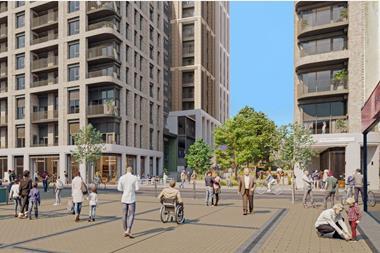Housing delivery is the central focus of the residential sector. But, despite the ambition to deliver new homes, challenges such as planning, build costs and low supply form powerful barriers.

Panel of experts
- Simon Chatfield, head of BTR, John Lewis
- David Christie, chief executive, Matter Real Estate
- Kathleen Corbett, chief financial officer, Milton Keynes Development Partnership
- Jacqui Daly, director of residential investment research and strategy, Savills
- Samantha Kempe, chief investment officer, IMMO
- David Mawson, chief executive, Placefirst
- David Reid, managing director of the L&G suburban build-to-rent business, Legal & General Capital
- Rob Sumner, residential investment director, Sigma Capital Group
- Duncan Williams, head of land and planning, Present Made
- Stephanie Denton, head of content, Property Week
This, alongside growing demand for build-to-rent (BTR), single-family housing (SFH) and affordable homes, has brewed headwinds for investors, developers and agents alike.
Property Week and build-to-rent provider Placefirst recently gathered a group of senior figures from across the industry to share ideas and discuss how the sector can tackle these challenges and meet demand.
Market growth
With demand for rental properties growing, the first question on the agenda was that of market growth. In particular, the growth of the single-family housing market, and the direction it is expected to travel. “The potential size is enormous,” said David Mawson, chief executive of Placefirst.
“The size is driven by the demand. Single-family housing, a part of the BTR sector, is an area where there will be enormous growth. We have got to find that growth and make it work.” SFH developments – also known as single-family rental or suburban BTR – are neighbourhoods of homes designed and built specifically for rent and professionally managed.
Mawson said one of the largest hurdles was “a lack of housing”, which is resulting in a gap in the market. “There is an inability with mortgage rates rising, housebuilders slowing down on their development and people not qualifying for social housing, creating a real gap in the market.”
David Reid, managing director of the L&G Suburban BTR business, echoed Mawson’s argument. “The sector will grow,” he said. “The fundamental economics are good for it.”
There is a real opportunity for institutions to come into the existing space and do retrofits
Samantha Kempe
Kathleen Corbett, chief financial officer at Milton Keynes Development Partnership, highlighted the positive relationship between consumers and institutional landlords.
“There is a big desire to have a professional landlord,” she said. “You haven’t got somebody who is going to want their property back because they want to sell it or move back into it.”
Simon Chatfield, head of BTR at John Lewis, said this could be extended into the wider BTR sector and that part of this growth is a result of changing mindsets. “BTR has done a huge amount to say there is an alternative to the landlord who might not look after you quite as well as you would have hoped for.”
He added: “There is a place where you can get a good-quality home with a high level of service. There is now that changing aspiration from people to say: ‘Actually, maybe I will rent for a few years.’”
Duncan Williams, head of land and planning at Present Made, added: “People inherently move into single-family assets with the aspiration of buying at some point, and the challenge is making it a lifestyle choice.If someone is moving into a freshly managed development that has lots of amenities, it is worth highlighting what are you offering them that they wouldn’t get from buying their own house.”
Reid stressed that brand can be an important factor, with a trusted brand attracting not only customer interest but also investors. “Building a brand is so important for the consumer to understand and trust their landlord,” he said. “Look at businesses that have had tenants for much longer: that stickiness is really important to give support to the long-term investor.”
It was not long before the UK single-family model was compared to that of the US, with Samantha Kempe, chief investment officer at IMMO, discussing how it utilises existing stock. “Last year, around $60bn (£45.7bn) was invested in that market – about 95% of that was into existing stock,” she said.
“There is no question about the need for more new-builds coming through. But that is not the only option for institutions to be accessing. People are still in this box, thinking residential has to be new-build, and that is not the case.”
Kempe added that a “mindset shift” was needed and highlighted the 25% of UK homes that were found last year to be substandard by the Department for Levelling Up, Housing and Communities.
“The quality of the housing stock out there is terrible,” she noted. “There is a real opportunity for institutions to come into the existing space and do retrofits and raise energy performance certificate standards and living standards.”
However, despite growing demand, Jacqui Daly, director of residential investment research and strategy at Savills, suggested that despite being “brilliant”, the single-family model is “only a tiny part of the whole sector” with “tenants expanding into every part of the market”.
She added: “Whether it is buy-to-let, medium-sized landlord or a new-build, government data shows this rental sector has doubled over the past 10 years in cities everywhere. But what is important is establishing an identity for what your single-family sector is trying to do and offering.”
David Christie, chief executive of Matter Real Estate, warned that the sector needed to attract the attention of government to grow successfully.
“It is ambitious to suggest that it is an exponential growth, just from the experiences I have had over the past five years,” he said. “Given that there is a general election coming up next year, this space needs to have a voice that makes sure it is defined in the eyes of policymakers.”
Institutional landlords
Everyone at the table agreed that institutional landlords play a vital role in supporting delivery and maintaining the quality of homes, whether through attracting residents or attracting investors to the sector – and key workers are a major market for this.
Williams highlighted research from the University of Cambridge, which found that 100% of key worker housing tenants would be willing to stay in their accommodation due to the location and amenities it provides.
“Over 20% of our residents work for the NHS,” said Mawson. “Key workers, NHS, teachers, doctors – these are the people renting from us day in, day out. They choose to rent these types of properties because it has given them the quality.” He added that this was also a welcome space for institutional investors because “those key workers are always going to be required”.
“When we start looking at the people coming to us, they are all working and they are happy to rent and are renting for longer. Local hospitals are struggling to recruit because people have got nowhere to live.”
ESG
The discussion then moved on to regulations due to come into effect around environmental, social and governance (ESG), which the industry has no choice but to face head-on. While the table acknowledged the importance of the S and G, most felt it was the environmental regulations that would prove to be most challenging.
With targets to reach net zero carbon emissions by as soon as 2030, the industry needs to address the sustainability not only of new-builds but also that of existing stock. However, with around 40% of the UK’s carbon emissions accredited to the property industry, the task of retrofitting existing buildings does not lie with institutional landlords alone. Kempe highlighted this as one of the primary challenges moving forward.
“We have some of the most inefficient housing stock in Europe – it is terrible,” she said. “I don’t see how buy-to-let landlords are going to be able to undertake that level of retrofit themselves.”
They choose to rent these types of properties because it has given them the quality
David Mawson
She added: “We are essentially relying on consumers and unprofessional landlords to take on this challenge across the UK. The reality is that it is not going to happen; it needs institutions moving into this space.”
Christie suggested that institutional capital is the primary driver for the ESG agenda. “As this sector is growing, it is becoming more responsible for its self-regulation.
“It is like watching one of your kids walk for the first time: it is welcome but it does not look very pretty. The ESG regulations are a step in the right direction, but they will be refined to make them more meaningful in time. The pace this is happening at is pretty impressive.”
Rob Sumner, residential investment director at Sigma Capital Group, added: “The thing about institutionalising this sector is that there are a number of layers to it. There is a vast pool of capital out there, which has shareholders and investment of its own. This is also where internal industry regulation is likely to come from.”

The importance of educating customers and the role of technology were also discussed as vital methods in meetings these targets. Williams said: “We can look at what goes into our buildings that allows customers to monitor their energy consumption. We can help them get an understanding of, for example, when you switch a light on or off, what impact that is having on the building. That technology allows the customer to take control of how they are using that asset.”
While the attendees regarded ESG as important, Reid suggested the introduction of a fourth letter: H for health. “How do you make these homes healthier for people?” he asked. “It is not just the quality of the homes; it is the social side and preventing loneliness, which is a huge issue.”
This sentiment was echoed by Sumner. “In a lot of ways the facilities of a house, a garden, a little bit more space and some home-working provision could actually improve if not the physical health, then certainly the mental health of the resident.”
Final thoughts
Overall, despite many challenges and hurdles to be overcome, the table was optimistic about the future of the market, but Reid called on the industry to “be patient”.
He added: “Lots of institutions over the past couple of years have looked at the sector and thought: ‘We must get into this and it is all going to happen tomorrow.’ It won’t. Have patience and the sector will evolve.”
Mawson concluded: “By working with residents and making them a part of the process, we get real benefits and can build neighbourhoods where they want to stay for the long term.
“There has to be an inclusion in local authorities’ strategic housing plans for BTR. There is the realisation now that this is a sector that is needed, and that has to be put in the strategic plan.”
Property Week’s inaugural BTR360 – Conference, Showcase and Awards – takes place on 10 October in London, addressing and connecting the full build-to-rent ecosystem, followed by a celebratory awards evening.
View the awards categories and start your entries today










































No comments yet